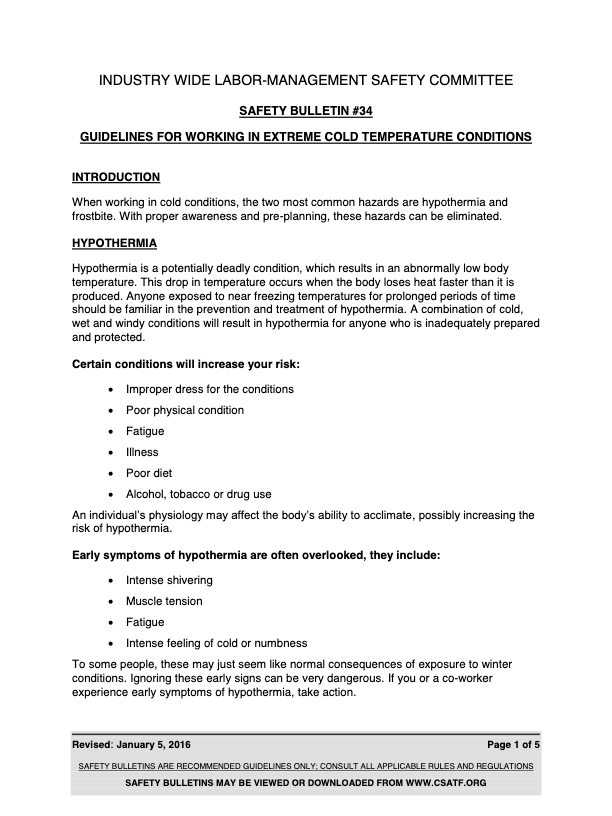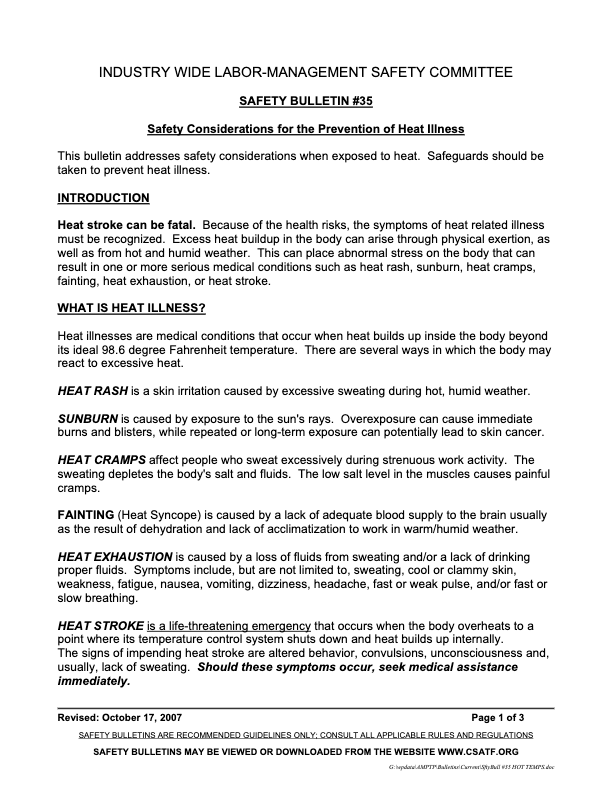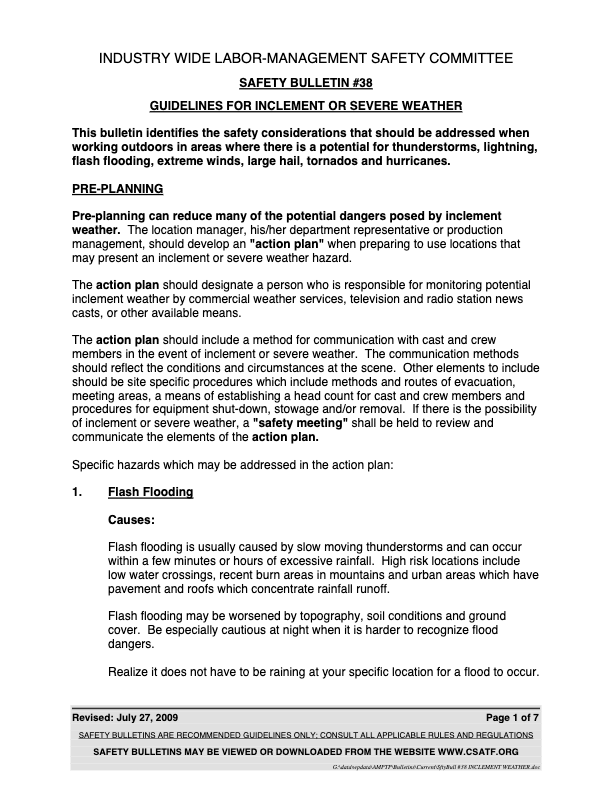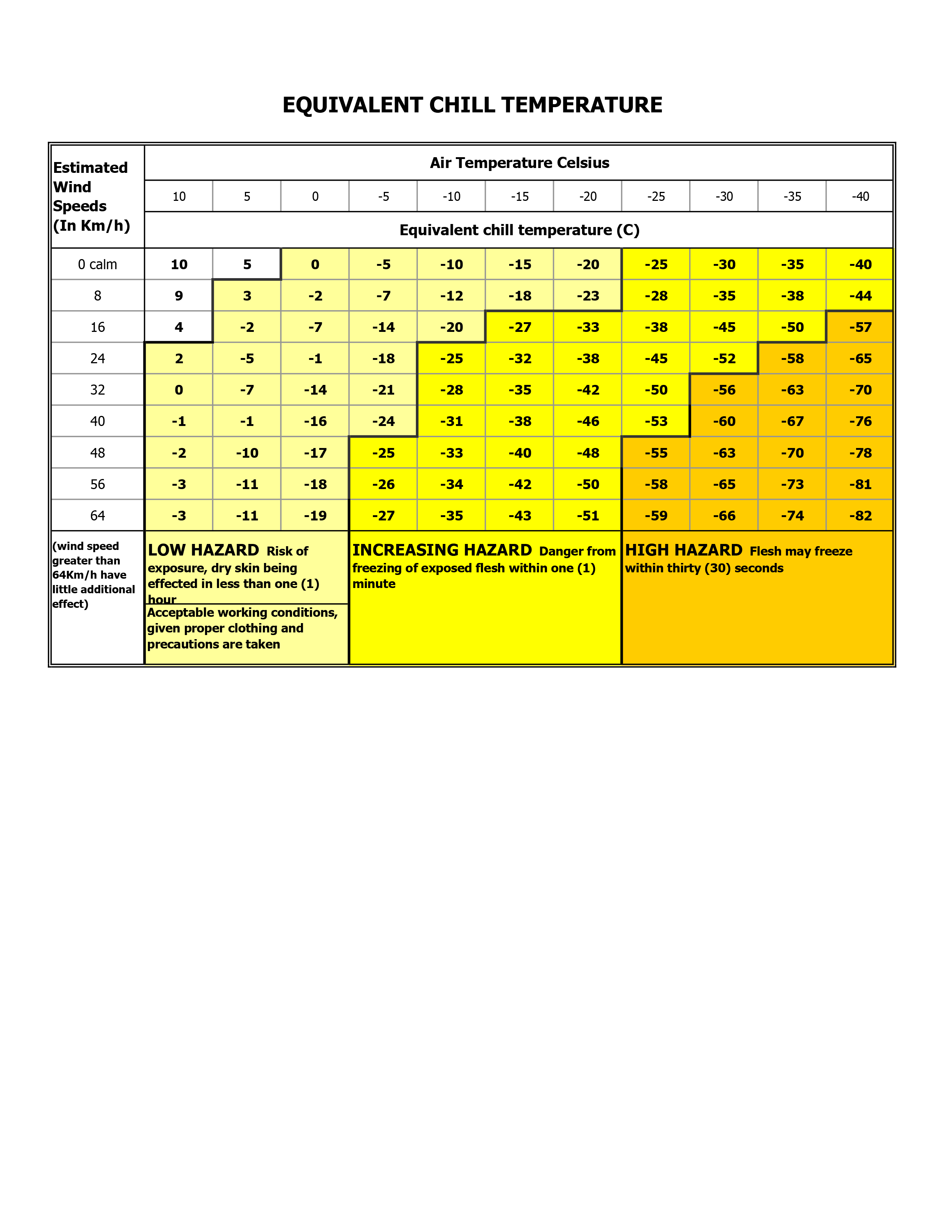These guidelines identify safety considerations that should be addressed when working outdoors in areas where there is a potential for inclement or severe weather conditions. Topics covered are:
- Pre-Planning
- Lightning
- Hurricanes
- Tornados
- Flash Flooding
- High Winds
- Large Hail
- Severe Snow
- Extreme Hot Temperatures
- Extreme Cold Temperatures
Pre-Planning
Pre-planning can reduce many of the potential dangers posed by inclement weather. The location manager, their department representative or production management, should develop an Action Plan when preparing to use locations that may present an inclement or severe weather hazard.
The Action Plan should designate a person who is responsible for monitoring potential inclement weather by commercial weather services, apps, television and radio station news casts, or other available means.
The Action Plan should include a method for communication with cast and crew members in the event of inclement or severe weather. The communication methods should reflect the conditions and circumstances at the scene. Other elements to include should be site specific procedures which include methods and routes of evacuation, meeting areas, a means of establishing a head count for cast and crew members and procedures for equipment shut-down, stowage and/or removal. If there is the possibility of inclement or severe weather, a safety meeting shall be held to review and communicate the elements of the Action Plan.
Lightning
Lightning results from the buildup and discharge of electrical energy in clouds. Lightning may strike several miles from an associated thunderstorm and may strike when no clouds or rain are present.
Potential Hazards
- Electrocution
- Burns
- Falling debris
- Concussion
- Fire
Possible Actions
- Activate the action plan
- When working in lightning prone areas, the use of a lightning detector/meter is highly recommended. If a meter is not available, it is possible to estimate the distance of lightning by the thunder. When lightning is seen, count the seconds until thunder is heard and then divide the seconds counted by five to obtain the approximate distance in miles.
- 30-30 rule: The first 30 means if you count to 30 seconds or less (from lightning to thunder), the lightning is within 6 miles of your location and you are in potential danger and should seek shelter. The second 30 means you should wait 30 minutes from the last flash or thunder to establish an “all clear.”
- Seek shelter in a sturdy building, a hardtop automobile or truck with the windows rolled up. If such cover is not available seek shelter in wooded areas with thick small trees. Avoid isolated trees.
- Avoid high ground and keep clear of tall objects, towers, aerial lifts, camera booms, scaffolding, fences or other metal equipment.
- Avoid contact with any body of water.
- Avoid using a telephone or cellular phone.
- Where appropriate, shut down generators in accordance with the established action plan.
- Avoid using other electrical equipment or appliances.
- When instructed, move to the pre-determined evacuation area.
- Do not attempt to return to the area until an “all clear” signal has been given by a regulatory authority and/or production management or 30 minutes after the last thunder sound is heard.
Hurricanes
A slow developing tropical weather phenomenon that forms over water. Its greatest impacts are felt near or on shorelines of land. You will not be surprised by a hurricane, as they are usually tracked by a weather service for many days. They are also known as cyclones or typhoons.
Potential Hazards
- Severe winds and rainfall, which may cause extreme flooding
- Storm surges
- High waves possibility of persons being swept off their feet
- Drowning
- Localized tornados
- Extreme damage to structures, roads, utilities, vehicles and boats
- Severe injury due to flying debris
Possible Actions
- In most cases, you will have several days warning to activate your action plan
- Do not stay by shoreline
- Pack and secure all equipment and remove to a safe area
- Lower all aerial lifts, camera booms and other equipment. Remove to a safe area as time permits
- If ordered to evacuate, leave area early — do not hesitate
- Do not attempt to return to the area until an “all clear” signal has been given by a regulatory authority or production management
Additional Notes
- OSHA mandates that aerial lifts and other like equipment are not to be operated when winds exceed 25 mph.
- Be aware that many of the same precautions (e.g., eye protection and securing equipment), can also apply to man-made wind effects such as rotor wash from airplanes or helicopters and large ritter fans.
Tornados
A tornado is a violent windstorm characterized by twisting, funnel-shaped wind. Tornados tend to occur in the afternoon and evening hours.
Potential Hazards
- Tornados are unpredictable and may form without warning
- Winds can exceed 200 to 300 mph
- Tornados may appear nearly transparent until dust and debris are picked up or a cloud forms within the funnel
- Severe damage can occur to structures
- The precise location of a touch down point cannot be determined
Possible Actions
- If a watch or warning has been issued, the action plan should be activated
- The crew should be regularly updated regarding any changes to potential weather conditions
- All cast and crew members must follow all instructions given
- No employees should be working on elevated equipment. This includes aerial lifts, scaffolds, camera booms, and other high areas
- Evacuate the area immediately if instructed by a regulatory authority or production management
- Only secure equipment if there is time and it can be done safely
- Do not attempt to return to the area until an all clear signal has been given by a regulatory authority or production management
Flash Flooding
Flash flooding is usually caused by slow moving thunderstorms and can occur within a few minutes or hours of excessive rainfall. High-risk locations include low water crossings, recent burn areas in mountains and urban areas which have pavement and roofs which concentrate rainfall runoff. Flash flooding may be worsened by topography, soil conditions and ground cover. Be especially cautious at night when it is harder to recognize flood dangers. Realize it does not have to be raining at your specific location for a flood to occur.
Potential Hazards
- Crew and equipment could become trapped or stranded as escape routes may be damaged and/or blocked.
- Equipment and personnel could be swept away or covered by water, mud or debris.
- Drowning
- Electrocution
- Mud slides
Possible Actions
- Activate the action plan.
- Secure equipment and all electrical power.
- Remove all cast and crew from elevated equipment, scaffolds, booms and sets.
- Stay clear of potential slide areas next to hillsides or on edges of cliff areas.
- Follow directions for evacuation procedures as outlined in the action plan.
- Gather at pre-determined evacuation point and ensure everyone is accounted for.
- If you come upon a flowing stream where water is above ankles, STOP! Turn around and go another way.
- Do not drive through moving water or a flooded roadway.
- Do not attempt to return to the area until an “all clear” signal has been given by a regulatory authority or production management.
High Winds
High winds can be associated with extreme weather phenomenon including thunderstorms, tornados, hurricanes, and high and low pressure systems. During the summer months in the Western States, thunderstorms often produce little rain but very strong wind gusts (some up to 100 mph) and dust storms.
Potential Hazards
- Flying debris
- Dust
- Possibility of persons being swept off their feet
- Equipment can be blown over and carried for a distance
- Set destruction
- Eye injuries
Possible Actions
- Activate the action plan
- Remove all cast and crew from elevated areas, sets, scaffolding and other high objects
- Lower all aerial, lighting, diffusion, camera boom equipment and tents
- Tie down and secure all loose equipment
- When instructed, seek refuge from the winds at your pre-determined safe area
- Be aware and protect your eyes from potential injury
- Do not attempt to return to the area until an “all clear” signal has been given by a regulatory authority or production management
Large Hail
Hail is usually associated with thunderstorms and is caused by freezing rain that can become very large.
Potential Hazards
- May cause injuries to crew and damage to equipment
Possible Actions
- If a watch or warning has been issued, the action plan should be activated and the crew should follow all instructions
- Secure and protect all equipment
- Get down from elevated areas, aerial lifts, booms, scaffold and other high areas
- When instructed, seek shelter at your pre-determined safe area
- Do not attempt to return to the area until an “all clear” signal has been given by a regulatory authority or production management
Severe Snow
A storm accompanied by strong winds creating blizzard conditions with blinding wind-driven snow, severe drifting, and dangerous wind chill.
Potential Hazards
- Blinding conditions
- Creation of snow drifts
- Dangerous wind chill factor
- Avalanche danger, being caught and/or buried
- Usually triggered by victim or members of victims party
- Generally occur with clear skies, little or no snow fall and light or calm winds
- The weak layer often consists of surface hoar, facets or depth hoar
- On 30-40 degree slopes, often at a convex part of the slope
Possible Actions
- If a watch or warning has been issued, the action plan should be activated and the crew should follow all instructions
- Secure and protect all equipment
- Get down from elevated areas, aerial lifts, booms, scaffold and other high areas
- Stay clear from potential avalanche areas
- When instructed, seek shelter at your pre-determined safe area
- Do not attempt to return to the area until an “all clear” signal has been given by a regulatory authority or production management
Extreme Hot Temperatures
Heat illnesses are medical conditions that occur when heat builds up inside the body beyond its ideal 98.6 degree Fahrenheit temperature. There are several ways in which the body may react to excessive heat.
- HEAT RASH is a skin irritation caused by excessive sweating during hot, humid weather.
- SUNBURN is caused by exposure to the sun’s rays. Overexposure can cause immediate burns and blisters, while repeated or long-term exposure can potentially lead to skin cancer.
- HEAT CRAMPS affect people who sweat excessively during strenuous work activity. The sweating depletes the body’s salt and fluids. The low salt level in the muscles causes painful cramps.
- FAINTING (Heat Syncope) is caused by a lack of adequate blood supply to the brain usually as the result of dehydration and lack of acclimatization to work in warm/humid weather.
- HEAT EXHAUSTION is caused by a loss of fluids from sweating and/or a lack of drinking proper fluids. Symptoms include, but are not limited to, sweating, cool or clammy skin, weakness, fatigue, nausea, vomiting, dizziness, headache, fast or weak pulse, and/or fast or slow breathing.
- HEAT STROKE is a life-threatening emergency that occurs when the body overheats to a point where its temperature control system shuts down and heat builds up internally.
The signs of impending heat stroke are altered behavior, convulsions, unconsciousness and, usually, lack of sweating. Should these symptoms occur, seek medical assistance immediately.
Heat illness is preventable. Know your limits and take time to adjust to the heat. Above all, DRINK PLENTY OF WATER and immediately report any signs of heat illness in yourself or others.
Symptoms of Heat Illness
Early heat illness signs and symptoms may not always follow a progressive pattern from a mild condition such as heat rash up to the life-threatening condition of heat stroke. Thirst alone is a poor indicator of how the body is reacting to heat. Know the symptoms of heat illness to watch for:
- Discomfort
- Headache
- Fatigue
- Loss of coordination
- Vomiting
- Seizures
- Fainting
- Blurry vision
- Confusion
- Dizziness
- Irritability
- Poor concentration
- Muscle pain/cramps
- Lack of sweating or excessive sweating
- Altered behavior
Tell a supervisor immediately if you think you or a co-worker are feeling ill from the heat.
Heat Illness Susceptibility Factors
There are many risk factors that increase susceptibility to heat illness. They include, but are not limited to:
- Environmental Conditions:
- Hot air temperature
- High relative humidity
- Physical activity
- Radiant heat from the sun or other source
- Personal protective equipment worn
- Lack of air movement
- Personal Conditions:
- A history of heat illness
- Insufficient water consumption
- Over/under weight
- Poor level of fitness
- Lack of acclimatization
- Poor medical condition
- Use of prescription and over the counter medications and other drugs
- Consumption of alcohol, caffeine, carbonated drinks, energy drinks
- Advanced age or young age
- On a low salt diet
Consult with a doctor if you know you have risk factors for heat illness.
Acclimatization
During the first few days of working in heat, the body needs time to adjust. This period of adjustment (acclimatization) varies by individual and can take up to a few weeks. During this acclimatization period you should:
- Start work slowly and increase the pace gradually. During a heat wave there is still a risk for heat illness even if previously acclimatized.
- Report to a supervisor if returning to work after an absence or illness, or when changing from a cool to a hot and/or humid climate.
- Supervisors and employees should be aware that acclimatization to heat can take several days and work/rest cycles should be scheduled accordingly.
Hydration
Dehydration occurs quickly no matter how well acclimatized to the heat. The average person loses between 1 and 2 quarts of fluid an hour in perspiration during heavy exertion in hot weather. The only way to replace the loss (and help the body continue to cool itself) is to drink water.
- Frequently drink small quantities of water throughout the entire work shift. A minimum of 1 quart (four 8-oz cups) per hour is recommended.
- Don’t wait until thirsty to drink water. Being thirsty is not a good signal for the need to hydrate. Drink water both before and after work. Avoid substituting soft drinks and coffee for water.
- Drinking water needs to be available for all employees at all work locations.
- Know the location(s) of the closest drinking water supplies.
Wear Appropriate Work Clothes and Cool Down Under Cover
- Know the nearest cool resting place(s). Get out of the sun or away from the source of heat and find a cool, preferably well ventilated, resting place when you are starting to overheat or need to cool down.
- Wear light-colored loose fitting long-sleeved shirt and pants, and UV sunglasses or, if appropriate, other protective equipment.
- Wear a wide brim hat (baseball caps do not cover the ears and neck).
- Use sunscreen or sun block and reapply as needed.
- Eat light meals. Hot, heavy meals add heat to the body.
Extreme Cold Temperatures
When working in cold conditions, the two most common hazards are hypothermia and frostbite. With proper awareness and pre-planning, these hazards can be eliminated.
Hypothermia
Hypothermia is a potentially deadly condition, which results in an abnormally low body temperature. A combination of cold, wet and windy conditions will result in hypothermia for anyone who is inadequately prepared and protected.
Early symptoms of hypothermia are often overlooked, they include:
- Intense shivering
- Muscle tension
- Fatigue
- Intense feeling of cold or numbness
To most people, these may just seem like normal consequences of exposure to winter conditions. Ignoring these early signs can be very dangerous. If you or a co-worker experience early symptoms of hypothermia, take action.
Also watch for additional behavioral signs including:
- Slurred speech
- Difficulty performing tasks
- Loss of coordination
- Lethargy
- Erratic behavior, poor decisions
- Irritability
- Slow breathing and heart rate
At the first sign of any of these conditions, notify your supervisor and/or seek medical attention (i.e., set medic, studio hospital or medical provider) then go inside and get warm, before you attempt to complete the job or project you are working on.
Hypothermia Prevention
Preventing hypothermia is not difficult. In fact, it is much easier to avoid hypothermia than to treat it after the fact. You can prevent hypothermia if you pre-plan, know what the conditions are expected to be and plan your clothing accordingly.
Clothing:
- Clothing does not warm you; it provides insulation to preserve your warmth. Layer your clothing
- As much as half of your body heat is lost through your head and neck, so keep them covered
- Keep rain and wind out of your clothing
- Avoid overheating and sweating by ventilating as needed
- Wool clothing is best followed by synthetics, down is okay if kept dry, but cotton is a bad choice
Food and behavior:
- Watch what you eat. Minor changes to your normal behavior are an important step in preventing hypothermia
- This is not the time for a starvation diet. It is important to maintain your optimal metabolism
- Take extra steps to stay warm and dry by preventing exposure to wind and water
If you are working in cold weather:
- Do not diet; give your body the appropriate nutrients
- This will increase your metabolism and help keep you warm
- Continue to drink fluids, water is best. No alcohol.
- If you do not need to be outside, go inside, even if it is only for a few minutes
- If you cannot go inside, exercise, jog in place, shake your arms, these activities will increase your circulation and increase heat
If someone is showing signs of hypothermia:
- Hypothermia symptoms should receive medical treatment as soon as possible
- Prevent further heat loss by sheltering from exposure to wind and water
- Bring the crew member inside to a warm area, if possible
- Treat the crew member gently
- Seek medical attention (*i.e., *set medic, studio hospital or medical provider)
- Remove any wet clothing and replace with dry clothing
- Wrap the crew member in blankets and cover their head
- No caffeine, alcohol or tobacco should be used
Frostbite
Frostbite is more common than hypothermia. It is the result of the freezing of the extracellular fluid in the skin, which can permanently damage the tissue. This condition usually affects the extremities, such as the tips of fingers, the ears and nose but other exposed areas can also be affected. Like hypothermia, a combination of elements usually leads to frostbite not cold air alone. In fact, most frostbite is the result of conduction, the rapid transfer of heat, for example, touching cold metal surfaces with bare hands. Exposure to cold temperatures and wind can quickly result in frostbite.
Signs and Symptoms of Frostbite:
- Mild frostbite affects the outer skin layers and appears as a blanching or whitening of the skin. This usually disappears as warming occurs, but the skin may appear red for several hours
- In severe cases the skin will appear waxy-looking with a white, gray-yellow or gray-blue color. The affected parts will have no feeling and blisters may be present. The tissue will feel frozen or “wooden”
- Other indicators are; swelling, itching, burning and deep pain as the area is warmed
Frostbite Prevention
Just as with hypothermia, frostbite is much easier to prevent than it is to treat. All of the items listed above for hypothermia would also apply for frostbite.
- Wear proper clothing which insulates from the cold and provides protection from wind, rain and snow
- Cover your neck and head
- Protect your hands and feet (mittens are warmer than gloves but may limit activity)
- Keep clothing and shoes loose, to ensure good circulation
- Drink plenty of fluids
- Do not diet; give your body the appropriate nutrients
- Alcohol, tobacco or drugs should not be used
- Keep moving, do not stand still
- Take breaks to go inside and warm up
- Never touch a cold metal object with your bare hands
Frostbite Treatment
If you think you may have frostbite, even a mild case, immediately seek medical attention. The following list will provide some guidelines for treating frostbite:
- Get to a place where you can stay warm after thawing; do not allow the affected body area to refreeze
- Seek medical attention (*i.e., *set medic, studio hospital or medical provider), re- warming should be conducted under medical supervision
- Warm water is best for re-warming; do not rub or massage the area, or use dry heat (sunlamp, radiator, heating pad)
- If blisters are present, leave them intact
- No alcohol, tobacco or drugs should not be used
General Precautions
The following are some additional steps the production can take to minimize the risks:
- Monitor local weather forecast information daily and conduct cold stress assessments for all areas
- Provide adequate heated shelters for cast and crew
- Maintain a suitable thermometer and anemometer (wind measuring device) at the site; these will be used to determine the equivalent chill temperature
- Charts for establishing acceptable working conditions based on temperature and wind speed, are attached
- Establish safe areas and paths, no wandering or sightseeing, this will reduce the risk of getting lost




